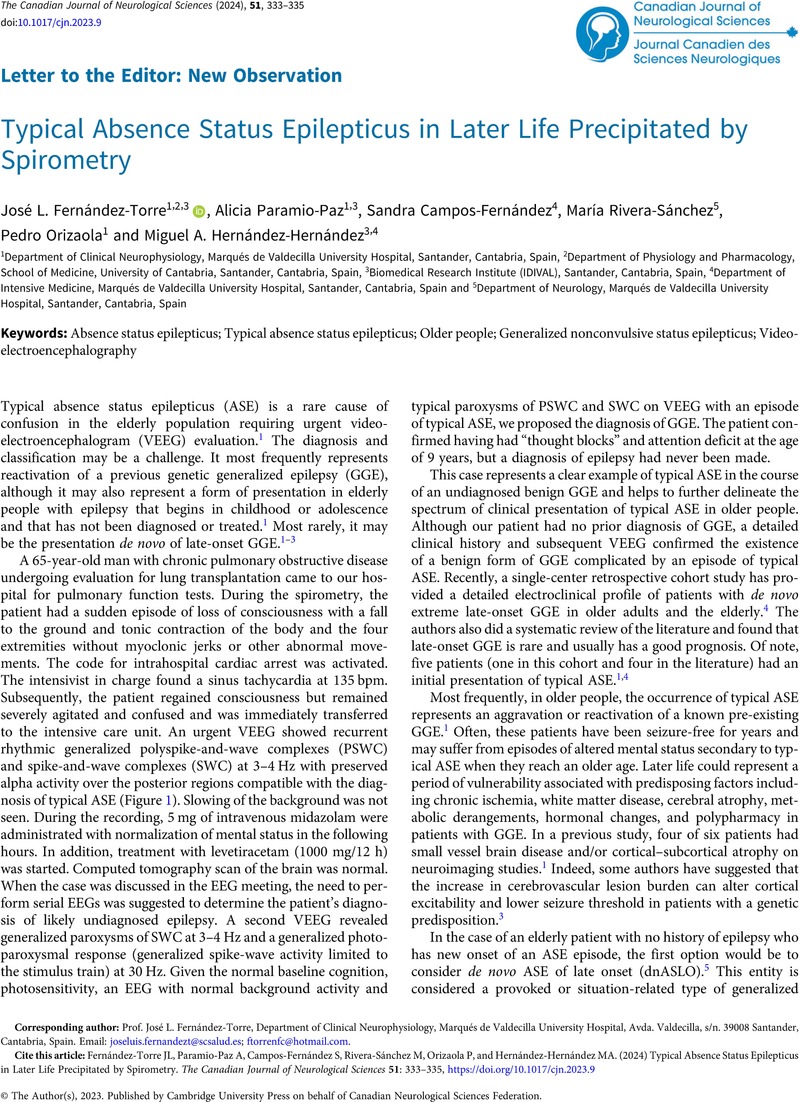No CrossRef data available.
Article contents
Typical Absence Status Epilepticus in Later Life Precipitated by Spirometry
Published online by Cambridge University Press: 20 January 2023
Abstract
An abstract is not available for this content so a preview has been provided. Please use the Get access link above for information on how to access this content.

Keywords
- Type
- Letter to the Editor: New Observation
- Information
- Copyright
- © The Author(s), 2023. Published by Cambridge University Press on behalf of Canadian Neurological Sciences Federation
References
Fernández-Torre, JL, Hernández-Hernández, MA, Orizaola, P, Paramio-Paz, A, Vázquez-Higuera, JL, Marco de Lucas, E. Typical absence status epilepticus in older people: syndromic delineation. Epileptic Disord. 2022;24:1–6. DOI: 10.1684/epd.2022.1422.CrossRefGoogle ScholarPubMed
Pro, S, Vicenzini, E, Randi, F, Pulitano, P, Mecarelli, O. Idiopathic late-onset absence status epilepticus: a case report with an electroclinical 14 years follow-up. Seizure. 2011;20:655–8. DOI: 10.1016/j.seizure.2011.03.009.CrossRefGoogle ScholarPubMed
Brigo, F, Tavernelli, V, Nardone, R, Trinka, E. De novo late-onset absence status epilepticus or late-onset idiopathic generalized epilepsy? A case report and systematic review of the literature. Epileptic Disord. 2018;20:123–31. DOI: 10.1684/epd.2018.0961.CrossRefGoogle ScholarPubMed
Alzahrany, M, Punia, V. Extreme late onset of genetic generalized epilepsy in older adults and the elderly: a cohort study and literature review. Epilepsia Open. 2022, DOI: 10.1002/epi4.12671.Google ScholarPubMed
Thomas, P, Beaumanoir, A, Genton, P, Dolisi, C, Chatel, M. De novo absence status of late onset: report of 11 cases. Neurology. 1992;42:104–10.CrossRefGoogle ScholarPubMed
Kane, N, Grocott, L, Kandler, R, Lawrence, S, Pang, C. Hyperventilation during electroencephalography: safety and efficacy. Seizure. 2014;23:129–34. DOI: 10.1016/j.seizure.2013.10.010.CrossRefGoogle ScholarPubMed




